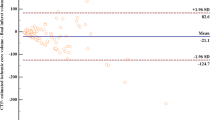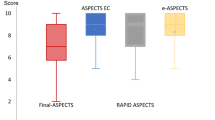Abstract
Purpose
A pseudo-normalization of infarcted brain parenchyma, similar to the “fogging effect” which usually occurs after 2–3 weeks, can be observed on CT performed immediately after endovascular stroke treatment (EST). Goal of this study was to analyze the incidence of this phenomenon and its evolution on follow-up imaging.
Methods
One hundred fifty-two patients in our database of 949 patients, who were treated for acute stroke between January 2010 and January 2015, fulfilled the inclusion criteria of (a) EST for an acute stroke in the anterior circulation, (b) an ASPECT-score < 10 on pre-interventional CT, and (c) postinterventional CT imaging within 4.5 h after the procedure. Two independent reviewers analyzed imaging data of these patients.
Results
Transformation of brain areas from hypoattenuated on pre-interventional CT to isodense on postinterventional CT was seen in 37 patients in a total of 49 ASPECTS areas (Cohen’s kappa 0.819; p < 0.001). In 17 patients, the previously hypoattenuated brain areas became isodense, but appeared swollen. In 20 patients (13%), the previously hypodense brain area could not be distinguished from normal brain parenchyma. On follow-up imaging, all isodense brain areas showed signs of infarction.
Conclusion
Pseudo-normalization of infarct hypoattenuation on postinterventional CT is not infrequent. It is most likely caused by contrast leakage in infarcted parenchyma and does not represent salvage of ischemic brain parenchyma.



Similar content being viewed by others
References
Berkhemer OA, Fransen PS, Beumer D, MR CLEAN Investigators et al (2009) A randomized trial of intraarterial treatment for acute ischemic stroke. N Engl J Med 372:11–20. doi:10.1056/NEJMoa1411587
Kim JT, Heo SH, Cho BH, Choi SM et al (2012) Hyperdensity on non-contrast CT immediately after intra-arterial revascularization. J Neurol 259:936–943
Parrilla G, García-Villalba B, Espinosa de Rueda M et al (2012) Hemorrhage/contrast staining areas after mechanical intra-arterial thrombectomy in acute ischemic stroke: imaging findings and clinical significance. AJNR Am J Neuroradiol 33:1791–1796
Lummel N, Schulte-Altedorneburg G, Bernau C et al (2014) Hyperattenuated intracerebral lesions after mechanical recanalization in acute stroke. AJNR Am J Neuroradiol 35:345–351
Nikoubashman O, Reich A, Gindullis M, Frohnhofen K, Pjontek R, Brockmann MA, Schulz JB, Wiesmann M (2014) Clinical significance of post-interventional cerebral hyperdensities after endovascular mechanical thrombectomy in acute ischaemic stroke. Neuroradiology 56:41–50. doi:10.1007/s00234-013-1303-1
Dekeyzer S, Nikoubashman O, Lutin B, De Groote J, Vancaester E, De Blauwe S, Hemelsoet D, Wiesmann M, Defreyne L (2016) Distinction between contrast staining and hemorrhage after endovascular stroke treatment: one CT is not enough. J Neurointerv Surg. doi:10.1136/neurintsurg-2016-012290
Pexman JH, Barber PA, Hill MD et al (2001) Use of the Alberta Stroke Program Early CT Score (ASPECTS) for assessing CT scans in patients with acute stroke. AJNR Am J Neuroradiol 22:1534–1542
Trouillas P, von Kummer R (2006) Classification and pathogenesis of cerebral hemorrhages after thrombolysis in ischemic stroke. Stroke 37:556–561. doi:10.1161/01.STR.0000196942.84707.71
Becker H, Desch H, Hacker H et al (1979) CT fogging effect with ischemic cerebral infarcts. Neuroradiology 18:185–192
Bech Skriver E, Skyhoj Olsen T (1981) Transient disappearance of cerebral infarcts on CT scan, the so-called fogging effect. Neuroradiology 22:61–65
Author information
Authors and Affiliations
Corresponding author
Ethics declarations
Funding
No funding was received for this study.
Conflict of interest
MW has received grants from Stryker Neurovascular and Siemens Healthcare; personal fees from Stryker Neurovascular, Silkroad Medical, Siemens Healthcare and Bracco; and non-financial support from Codman Neurovascular, Covidien, Abbott, St. Jude Medical, Phenox, Penumbra, Microvention/Terumo, B. Braun, Bayer, Acandis and ab medica.
Ethical approval
All procedures performed in studies involving human participants were in accordance with the ethical standards of the institutional and/or national research committee and with the 1964 Helsinki declaration and its later amendments or comparable ethical standards. For this type of study formal consent is not required.
Informed consent
For this type of retrospective study formal consent is not required.
Rights and permissions
About this article
Cite this article
Dekeyzer, S., Reich, A., Othman, A.E. et al. Infarct fogging on immediate postinterventional CT—a not infrequent occurrence. Neuroradiology 59, 853–859 (2017). https://doi.org/10.1007/s00234-017-1894-z
Received:
Accepted:
Published:
Issue Date:
DOI: https://doi.org/10.1007/s00234-017-1894-z




